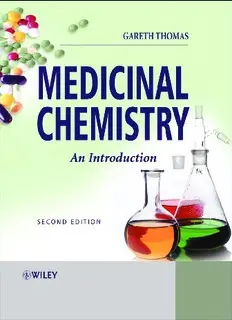
Medicinal chemistry : an introduction / Gareth Thomas PDF
Preview Medicinal chemistry : an introduction / Gareth Thomas
Medicinal Chemistry Second Edition Gareth Thomas University of Portsmouth Medicinal Chemistry Second Edition Medicinal Chemistry Second Edition Gareth Thomas University of Portsmouth Copyright#2007 JohnWiley&SonsLtd,TheAtrium,SouthernGate,Chichester, WestSussexPO198SQ,England Telephone(þ44)1243779777 Email(forordersandcustomerserviceenquiries):[email protected] Visit our Home Page on www.wileyeurope.com or www.wiley.com AllRightsReserved.Nopartofthispublicationmaybereproduced,storedinaretrievalsystemortransmittedinanyform orbyanymeans,electronic,mechanical,photocopying,recording,scanningorotherwise,exceptunderthetermsofthe Copyright,DesignsandPatentsAct1988orunderthetermsofalicenceissuedbytheCopyrightLicensingAgencyLtd,90 TottenhamCourtRoad,LondonW1T4LP,UK,withoutthepermissioninwritingofthePublisher.Requeststothe PublishershouldbeaddressedtothePermissionsDepartment,JohnWiley&SonsLtd,TheAtrium,SouthernGate, Chichester,WestSussexPO198SQ,England,[email protected],orfaxedto(þ44)1243770620. Designationsusedbycompaniestodistinguishtheirproductsareoftenclaimedastrademarks.Allbrandnames and productnamesusedinthisbookaretradenames,servicemarks,trademarksorregisteredtrademarksof theirrespective owners.ThePublisherisnotassociatedwithanyproductorvendormentionedinthisbook. Thispublicationisdesignedtoprovideaccurateandauthoritativeinformationinregardtothesubjectmattercovered. ItissoldontheunderstandingthatthePublisherisnotengagedinrenderingprofessionalservices.Ifprofessionaladviceor otherexpertassistanceisrequired,theservicesofacompetentprofessionalshouldbesought. OtherWileyEditorialOffices JohnWiley&SonsInc.,111RiverStreet,Hoboken,NJ07030,USA Jossey-Bass,989MarketStreet,SanFrancisco,CA94103-1741,USA Wiley-VCHVerlagGmbH,Boschstr.12,D-69469Weinheim,Germany JohnWiley&SonsAustraliaLtd,33ParkRoad,Milton,Queensland4064,Australia JohnWiley&Sons(Asia)PteLtd,2ClementiLoop#02-01,JinXingDistripark,Singapore129809 JohnWiley&SonsCanadaLtd,6045FreemontBlvd,Mississauga,Ontario,L5R4J3 Wileyalsopublishesitsbooksinavarietyofelectronicformats.Somecontentthatappearsinprintmaynotbe availableinelectronicbooks. AnniversaryLogoDesign:RichardJ.Pacifico LibraryofCongressCataloging-in-PublicationData Thomas,Gareth,Dr. Medicinalchemistry:anintroduction/GarethThomas.–2nded. p.;cm. Includesbibliographicalreferencesandindex. ISBN978-0-470-02597-0(cloth:alk.paper)–ISBN978-0-470-02598-7(pbk.:alk.paper) 1. Pharmaceuticalchemistry. I.Title. [DNLM:1. Chemistry,Pharmaceutical.2. DrugDesign.3. DrugEvaluation.4. Pharmacokinetics. QV744 T4567m2007] RS403.T4472007 615’.19–dc22 2007026412 BritishLibraryCataloguinginPublicationData AcataloguerecordforthisbookisavailablefromtheBritishLibrary ISBN978-0-470-02597-0(HB) 978-0-470-02598-7(PB) Typesetin10.5/13ptTimesRomanbyThomsonDigital PrintedandboundinGreatBritainbyAntonyRoweLtd.,Chippenham.,Wiltshire Thisbookisprintedonacid-freepaperresponsiblymanufacturedfromsustainableforestry inwhichatleasttwotreesareplantedforeachoneusedforpaperproduction. Contents Preface to the First Edition xv Preface to the Second Edition xvii Acknowledgements xix Abbreviations xxi 1 An introduction to drugs, their action and discovery 1 1.1 Introduction 1 1.2 What aredrugsand why doweneed newones? 1 1.3 Drug discoveryand design:ahistorical outline 3 1.3.1 Thegeneralstagesinmodern-daydrugdiscovery anddesign 7 1.4 Leads andanalogues: some desirable properties 9 1.4.1 Bioavailability 9 1.4.2 Solubility 10 1.4.3 Structure 10 1.4.4 Stability 11 1.5 Sources ofleads and drugs 14 1.5.1 Ethnopharmaceuticalsources 15 1.5.2 Plantsources 15 1.5.3 Marinesources 17 1.5.4 Microorganisms 18 1.5.5 Animalsources 20 1.5.6 Compoundcollections,databasesandsynthesis 20 1.5.7 Thepathologyofthediseasedstate 21 1.5.8 Marketforcesand‘me-toodrugs’ 21 1.6 Methods and routes ofadministration: the pharmaceuticalphase 21 1.7 Introduction to drugaction 24 1.7.1 Thepharmacokineticphase(ADME) 25 1.7.2 Thepharmacodynamicphase 32 1.8 Classification ofdrugs 33 1.8.1 Chemicalstructure 33 1.8.2 Pharmacologicalaction 34 1.8.3 Physiologicalclassification 34 1.8.4 Prodrugs 35 1.9 Questions 35 vi CONTENTS 2 Drug structure and solubility 37 2.1 Introduction 37 2.2 Structure37 2.3 Stereochemistry and drugdesign 38 2.3.1 Structurallyrigidgroups 38 2.3.2 Conformation 39 2.3.3 Configuration 41 2.4 Solubility 44 2.4.1 Solubilityandthephysicalnatureofthesolute 44 2.5 Solutions 46 2.6 The importanceofwater solubility 47 2.7 Solubility andthe structureof thesolute 49 2.8 Salt formation 50 2.9 The incorporationofwater solubilising groupsin astructure 52 2.9.1 Thetypeofgroup 52 2.9.2 Reversibleandirreversiblegroups 53 2.9.3 Thepositionofthewatersolubilisinggroup 53 2.9.4 Methodsofintroduction 54 2.9.5 Improvinglipidsolubility 59 2.10 Formulation methodsof improving water solubility 59 2.10.1 Cosolvents 59 2.10.2 Colloidalsolutions 59 2.10.3 Emulsions 60 2.11 The effect ofpHonthesolubility of acidicandbasic drugs 61 2.12 Partition 63 2.12.1 Practicaldeterminationofpartitioncoefficients 65 2.12.2 Theoreticaldeterminationofpartitioncoefficients 66 2.13 Surfactants and amphiphiles 66 2.13.1 Drugsolubilisation 69 2.13.2 Mixedmicellesasdrugdeliverysystems 71 2.13.3 Vesiclesandliposomes 72 2.14 Questions 72 3 Structure–activity and quantitative structure relationships 75 3.1 Introduction 75 3.2 Structure–activity relationship (SAR) 76 3.3 Changing sizeand shape 77 3.3.1 Changingthenumberofmethylenegroupsinchainsandrings 77 3.3.2 Changingthedegreeofunsaturation 78 3.3.3 Introductionorremovalofaringsystem 78 3.4 Introduction ofnewsubstituents 80 3.4.1 Methylgroups 81 3.4.2 Halogengroups 83 3.4.3 Hydroxygroups 84 3.4.4 Basicgroups 84 3.4.5 Carboxylicandsulphonicacidgroups 85 3.4.6 Thiols,sulphidesandothersulphurgroups 85 3.5 Changing theexistingsubstituents of alead 86 3.6 Casestudy: aSAR investigation todiscover potent geminalbisphosphonates 87 3.7 Quantitative structure–activity relationship (QSAR) 90 3.7.1 Regressionanalysis 93 3.7.2 Thelipophilicparameters 94 CONTENTS vii 3.7.3 Electronicparameters 99 3.7.4 Stericparameters 102 3.8 Questions 110 4 Computer-aided drug design 113 4.1 Introduction 113 4.1.1 Models 114 4.1.2 Molecularmodellingmethods 115 4.1.3 Computergraphics 116 4.2 Molecular mechanics 117 4.2.1 Creatingamolecularmodelusingmolecularmechanics 120 4.3 Molecular dynamics 123 4.3.1 Conformationalanalysis 124 4.4 Quantum mechanics 124 4.5 Docking 127 4.5.1 Denovodesign 128 4.6 Comparing three-dimensional structures bythe useofoverlays 130 4.6.1 Anexampleoftheuseofoverlays 132 4.7 Pharmacophores and some oftheir uses 133 4.7.1 High-resolutionX-raycrystallographyorNMR 133 4.7.2 Analysisofthestructuresofdifferentligands 134 4.8 Modelling protein structures 135 4.9 Three-dimensional QSAR 136 4.9.1 Advantagesanddisadvantages 140 4.10 Other usesofcomputers indrug discovery 141 4.11 Questions 143 5 Combinatorial chemistry 145 5.1 Introduction 145 5.1.1 Thedesignofcombinatorialsyntheses 147 5.1.2 Thegeneraltechniquesusedincombinatorialsynthesis 148 5.2 The solidsupport method 148 5.2.1 Generalmethodsinsolidsupportcombinatorialchemistry 150 5.2.2 Parallelsynthesis 152 5.2.3 Furka’smixandsplittechnique 155 5.3 Encodingmethods 157 5.3.1 Sequentialchemicaltagging 157 5.3.2 Still’sbinarycodetagsystem 160 5.3.3 Computerisedtagging 161 5.4 Combinatorial synthesis in solution 161 5.4.1 Parallelsynthesisinsolution 162 5.4.2 Theformationoflibrariesofmixtures 163 5.4.3 Librariesformedusingmonomethylpolyethyleneglycol(OMe-PEG) 164 5.4.4 Librariesproducedusingdendrimersassolublesupports 164 5.4.5 Librariesformedusingfluorocarbonreagents 165 5.4.6 Librariesproducedusingresin-boundscavengingagents 166 5.4.7 Librariesproducedusingresin-boundreagents 168 5.4.8 Resincaptureofproducts 168 5.5 Deconvolution 169 5.6 High-throughput screening(HTS) 170 5.6.1 Biochemicalassays 171 5.6.2 Wholecellassays 173 5.6.3 Hitsandhitrates 173
